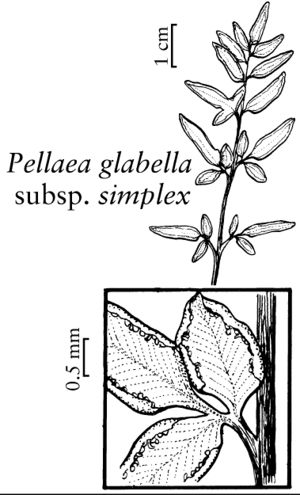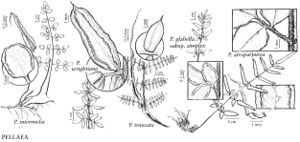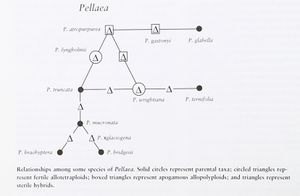Pellaea
Fil. Spec. 59. 1841.
| Taxon | Illustrator ⠉ | |
|---|---|---|
 | Pellaea glabella subsp. simplex | John Myers |
 | Pellaea atropurpurea Pellaea wrightiana Pellaea intermedia Pellaea truncata | John Myers John Myers John Myers John Myers |
Plants usually on rock. Stems compact to long-creeping, ascending to horizontal, usually branched; scales brown to tan or often bicolored with dark, central stripe and lighter margins, linear-subulate to lanceolate (rarely ovate), margins dentate, erose, or entire. Leaves monomorphic to somewhat dimorphic, clustered to widely scattered, 2–100 cm. Petiole brown, black, straw-colored, or gray, rounded, flattened or with single longitudinal groove adaxially, glabrous or pubescent, usually with a few scales at base, with single vascular-bundle. Blade linear to ovate-deltate, 1–4-pinnate proximally, leathery or rarely somewhat herbaceous, abaxially glabrous, pubescent, or with hairlike scales scattered along costae, adaxially usually glabrous, dull, not striate; rachis straight or flexuous. Ultimate segments of blade usually stalked and free from costae, elliptic, lanceolate to linear, usually more than 4 mm wide; base rounded, truncate, or cordate; stalks often lustrous and dark colored; segment margins reflexed to form confluent, poorly defined, false indusia extending entire length of segment. Veins of ultimate segments free or rarely anastomosing, usually obscure, pinnately branched and divergent distally. False indusia greenish to whitish, narrow, clearly marginal, often concealing the sporangia. Sporangia scattered along veins near segment margins, containing 32 or 64 spores, often intermixed with glands, farina-producing. Spores brown to tan (rarely yellow), tetrahedral-globose, rugose or cristate, lacking prominent equatorial-ridge. x = 29.
Distribution
Most in the Western Hemisphere, a small number in Asia, Africa, the Pacific Islands, and Australia
Discussion
Pellaea in the broad sense is a diverse, poorly defined assemblage of xeric-adapted ferns (A. R. Smith 1981). Relationships among the North American, neotropical, and Eastern Hemisphere species are unclear, and it seems likely that the genus, as broadly construed by E. B. Copeland (1947) and R. M. Tryon and A. F. Tryon (1982), is polyphyletic. The species included here in Pellaea belong to a closely knit alliance that is usually recognized as a distinct section (sect. Pellaea). Although the inclusion of P. bridgesii in this group has been questioned (A. F. Tryon 1957), W. H. Wagner Jr. et al. (1983) have shown that the aberrant morphology of this species is simply an extreme expression of evolutionary trends commonly encountered in sect. Pellaea.
Among Western Hemisphere cheilanthoid ferns, species of Pellaea show clear morphologic, chromosomal, and biochemical affinities to Argyrochosma and members of the Cheilanthes alabamensis complex. In fact, the glabrous species of Argyrochosma (A. jonesii and A. microphylla) are commonly misidentified as Pellaea. These species are easily recognizable, however, because they have a combination of concolored stem scales and small ultimate segments (less than 4 mm wide).
Species ca. 40 (15 in the flora).
Selected References
Lower Taxa
Key
| 1 | Petioles and rachises straw-colored, tan, or gray, rarely lustrous; stem scales narrowly lanceolate to ovate, largest more than 0.3 mm wide. | > 2 |
| 1 | Petioles and rachises dark brown to black, usually lustrous; stem scales linear-subulate, less than 0.3 mm wide. | > 5 |
| 2 | Rachises and costae strongly flexuous; pinnae retrorse, projecting downward toward base of leaf. | Pellaea ovata |
| 2 | Rachises and costae straight or slightly flexuous; pinnae perpendicular to rachis or ascending. | > 3 |
| 3 | Stems stout and compact, more than 5 mm diam.; stem scales uniformly orange-brown and thin; ultimate segments rotund-cordate to deltate-cordate. | Pellaea cordifolia |
| 3 | Stems slender and long-creeping, less than 5 mm diam.; stem scales mostly bicolored, with black, thick center and brown, thin margins; ultimate segments elliptic to ovate-deltate, not deeply cordate. | > 4 |
| 4 | Ultimate segments leathery, veins obscure abaxially; croziers only slightly scaly; blades usually 2-pinnate at base. | Pellaea intermedia |
| 4 | Ultimate segments somewhat herbaceous, veins visible abaxially; croziers densely scaly; blades usually 3-pinnate at base. | Pellaea andromedifolia |
| 5 | Some stem scales bicolored, with dark central region and lighter, brown margin. | > 6 |
| 5 | Stem scales uniformly reddish brown or tan. | > 11 |
| 6 | Leaf blades linear, 1-pinnate throughout, pinnae entire; fertile ultimate segments with rounded apices; segment margins not recurved, not concealing sporangia. | Pellaea bridgesii |
| 6 | Leaf blades linear-oblong to deltate, pinnate-pinnatifid to 3-pinnate, at least some pinnae lobed or divided; fertile ultimate segments with mucronate apices; segment margins recurved, usually concealing sporangia. | > 7 |
| 7 | Leaf blades deeply pinnate-pinnatifid at base, basal pinnae ternately lobed; petioles dark purple or black; sporangia not intermixed with farina-producing glands. | Pellaea ternifolia |
| 7 | Leaf blades 2–3-pinnate at base, basal pinnae fully pinnate (occasionally appearing ternate but with terminal segment on short, dark stalk); petioles chestnut brown to dark reddish brown; sporangia intermixed with glands producing yellowish farina (sparse in Pellaea wrightiana). | > 8 |
| 8 | Pinna costae usually shorter than or equal to ultimate segments; largest pinnae divided into 3–11 segments; blades linear-oblong, usually less than 4.5 cm wide. | > 9 |
| 8 | Pinna costae much longer than ultimate segments; largest pinnae divided into 11 or more segments; blades ovate-deltate to lanceolate, usually more than 4.5 cm wide. | > 10 |
| 9 | Ultimate segments linear, with greenish, strongly recurved margins covering more than 1/2 abaxial surface; sporangia with short stalks; pinnae strongly ascending. | Pellaea brachyptera |
| 9 | Ultimate segments narrowly oblong, with white-bordered, recurved margins usually covering less than 1/2 abaxial surface; sporangia with long stalks; pinnae perpendicular to rachis or slightly ascending. | Pellaea wrightiana |
| 10 | Blades usually 2-pinnate proximally, pinnae perpendicular to rachis or slightly ascending; margins of ultimate segments with whitish borders; sporangia with long stalks. | Pellaea truncata |
| 10 | Blades 3-pinnate proximally or, if 2-pinnate, pinnae strongly ascending; margins of ultimate segments with greenish borders; sporangia with short stalks. | Pellaea mucronata |
| 11 | Ultimate segments glabrous abaxially or with isolated hairlike scales on a few segments or, if sparsely villous, then rachises nearly glabrous; pinnae or costae slightly decurrent on rachis; blades linear-oblong to lanceolate. | > 12 |
| 11 | Ultimate segments sparsely villous on abaxial costae; rachises variously pubescent; pinnae or costae not decurrent on rachis (obscurely so in Pellaea gastonyi); blades lanceolate, ovate, or deltate. | > 13 |
| 12 | Proximal pinnae usually bilobed and mitten-shaped; petioles with prominent articulation lines near base; rachises of mature leaves green in distal portion of blade; sporangia sessile or subsessile. | Pellaea breweri |
| 12 | Proximal pinnae deeply divided into 3–7 lobes or segments (occasionally simple); petioles lacking articulation lines or, if present, then rachises of mature leaves brown to terminal pinna; some sporangia long-stalked. | Pellaea glabella |
| 13 | Adaxial surface of rachis densely covered with short, curly, appressed hairs; largest ultimate segments (excluding terminal pinnae) usually more than 30 mm. | Pellaea atropurpurea |
| 13 | Adaxial surface of rachis with sparse, long, divergent hairs; largest ultimate segments (excluding terminal pinnae) usually less than 30 mm. | > 14 |
| 14 | Proximal pinnae divided into 7–15 ultimate segments, segments shorter than longest pinna costae; fertile leaves usually more than 6 cm wide. | Pellaea lyngholmii |
| 14 | Proximal pinnae divided into 3–7 ultimate segments, some segments longer than longest pinna costae; fertile leaves usually less than 6 cm wide. | Pellaea gastonyi |
